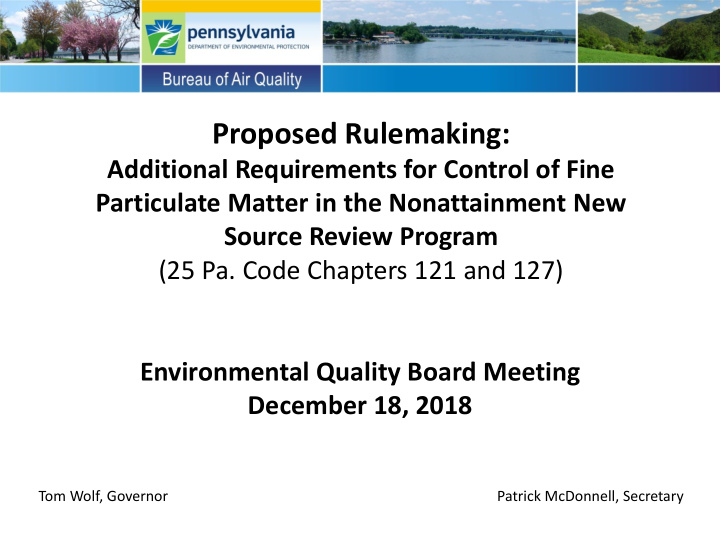



Proposed Rulemaking: Additional Requirements for Control of Fine Particulate Matter in the Nonattainment New Source Review Program (25 Pa. Code Chapters 121 and 127) Environmental Quality Board Meeting December 18, 2018 Tom Wolf, Governor Patrick McDonnell, Secretary
Background • On August 24, 2016, the United States Environmental Protection Agency (EPA) issued State Implementation Plan (SIP) requirements for the Fine Particulate Matter National Ambient Air Quality Standard (NAAQS). • The EPA’s implementation rule requires states with nonattainment areas for particulate matter less than and equal to 2.5 micrometers in diameter (PM 2.5 ) to amend their nonattainment new source review (NNSR) regulations to include emissions of volatile organic compounds (VOC) and ammonia as PM 2.5 precursors. 2
Purpose of Proposed Rulemaking • This proposed rulemaking will update the NNSR regulations to include VOC and ammonia as PM 2.5 precursors. • This proposed rulemaking is necessary to address a mandatory 18-month sanction clock, in accordance with section 179 of the Clean Air Act (CAA), following the EPA determination that Pennsylvania has not met its obligations for the NNSR permit program. • To stop the sanction clock, the commonwealth will need to submit the final rulemaking to EPA for administrative and technical review by November 7, 2019. 3
Addressing Nonattainment Areas • Allegheny, Delaware, and Lebanon Counties are currently designated as nonattainment areas for PM 2.5 . • Delaware and Lebanon Counties are currently meeting the 2012 PM 2.5 standard. • The Department is currently preparing maintenance plans and redesignation requests to submit to the EPA to reclassify Delaware and Lebanon Counties as attainment for the 2012 PM 2.5 standard. • Allegheny County Health Department is preparing an attainment demonstration for the Allegheny County PM 2.5 nonattainment area. 4
Proposed Rulemaking • Proposed amendments to Chapter 127, Subchapter E (relating to new source review) would: – Establish that emissions of VOC and ammonia are precursors to PM 2.5 for new major sources or major sources being modified in counties that are designated as nonattainment for the PM 2.5 NAAQS. – Propose significant impact levels (SIL) for PM 2.5 . – Propose offset ratios for emissions of VOC and ammonia as PM 2.5 precursors. 5
Proposed Rulemaking • This proposed rulemaking would amend three terms in § 121.1 (relating to definitions) to support the amendments to Chapter 127, Subchapter E: – Major facility – Regulated NSR pollutant – Significant 6
Proposed Rulemaking • This proposed rulemaking would provide flexibility by allowing for the submission of applications for the use of general permits for portable sources through any means, including electronic submission. 7
Affected Parties • The proposed rulemaking would affect major emitters of ammonia or VOC that are located in, or that would have a significant impact on, counties currently designated as nonattainment areas for PM 2.5 . • It is unlikely that any facility within a designated PM 2.5 attainment area will have a significant impact on a designated PM 2.5 nonattainment area. 8
Affected Parties • No new major facilities are known to be under construction, or planned to be constructed, within PM 2.5 nonattainment areas that will emit major amounts of VOC or ammonia. • There are 17 facilities that have the potential to emit 100 tons per year or greater of VOC, ammonia, or both. The owners and operators of these facilities would be subject to the proposed rulemaking if they undertake major modifications for VOC, ammonia, or both. There are no pending major modifications at these facilities. 9
Advisory Committee Review • The following committees concurred with the Department’s recommendation to move the proposed rulemaking to the EQB for consideration: – Small Business Compliance Advisory Committee (SBCAC) – July 25, 2018 – Air Quality Technical Advisory Committee (AQTAC) – August 2, 2018 – Citizens Advisory Council (CAC) Policy and Regulatory Oversight (PRO) Committee – August 21, 2018 10
Advisory Committee Review • The CAC PRO Committee briefed the members of the CAC on September 18, 2018. The CAC provided the Board with a letter of concurrence supporting the proposed rulemaking with comments suggesting clarification to the definition of “major facility” and justification for the proposed ammonia significance threshold . • The proposal addresses the CAC comments. 11
Recommendation and Public Participation • The Department recommends the adoption of this proposed rulemaking. The proposed rule will have a 60-day public comment period and three public hearings. • If adopted as a final-form rulemaking, a revision to the SIP will be submitted to the EPA. 12
George Hartenstein Deputy Secretary Waste, Air, Radiation and Remediation ghartenste@pa.gov Elizabeth Davis Assistant Counsel Bureau of Regulatory Counsel elidavis@pa.gov
Recommend
More recommend